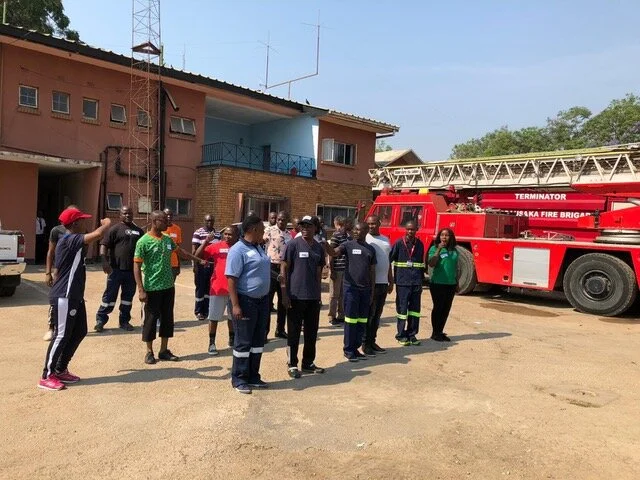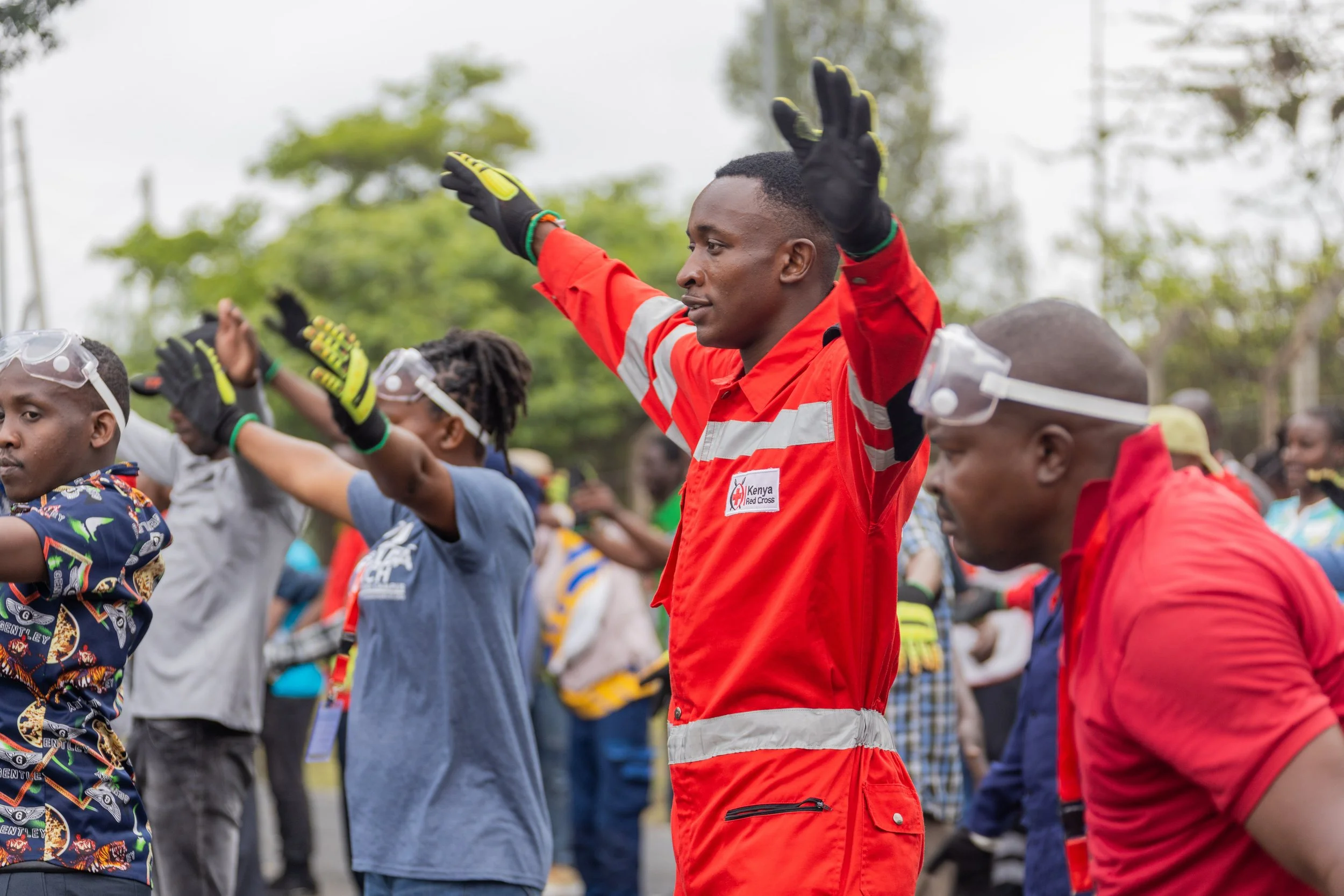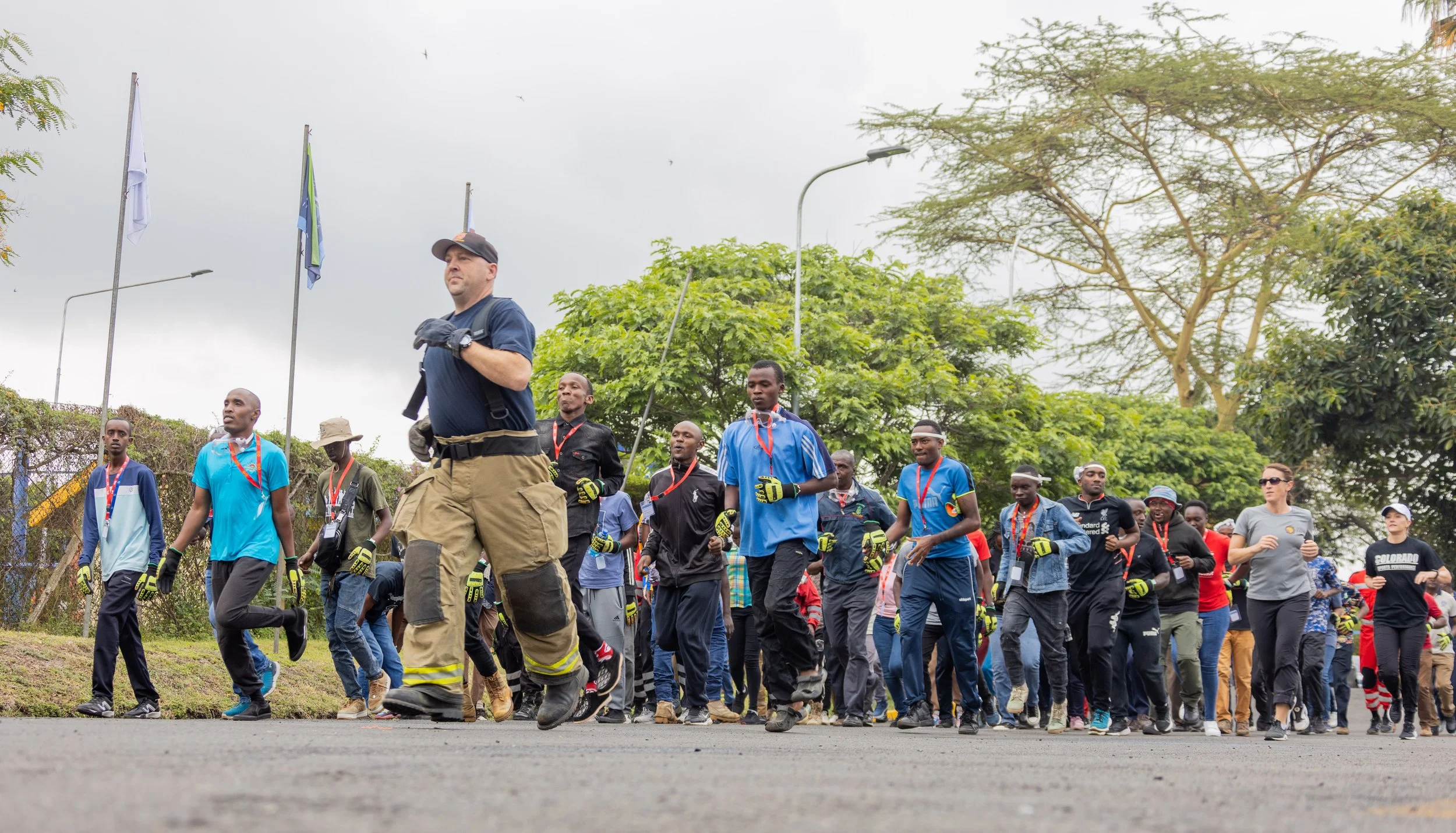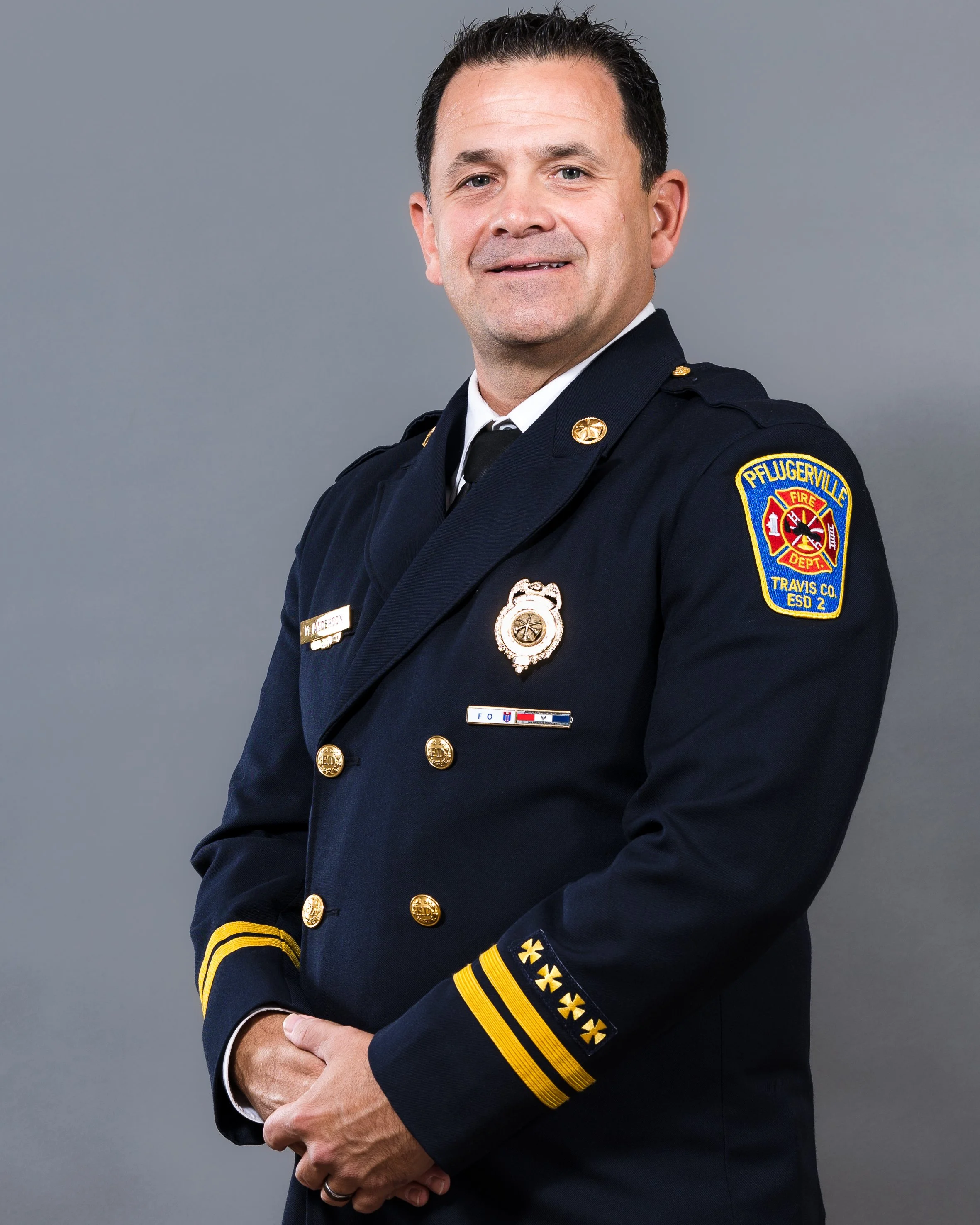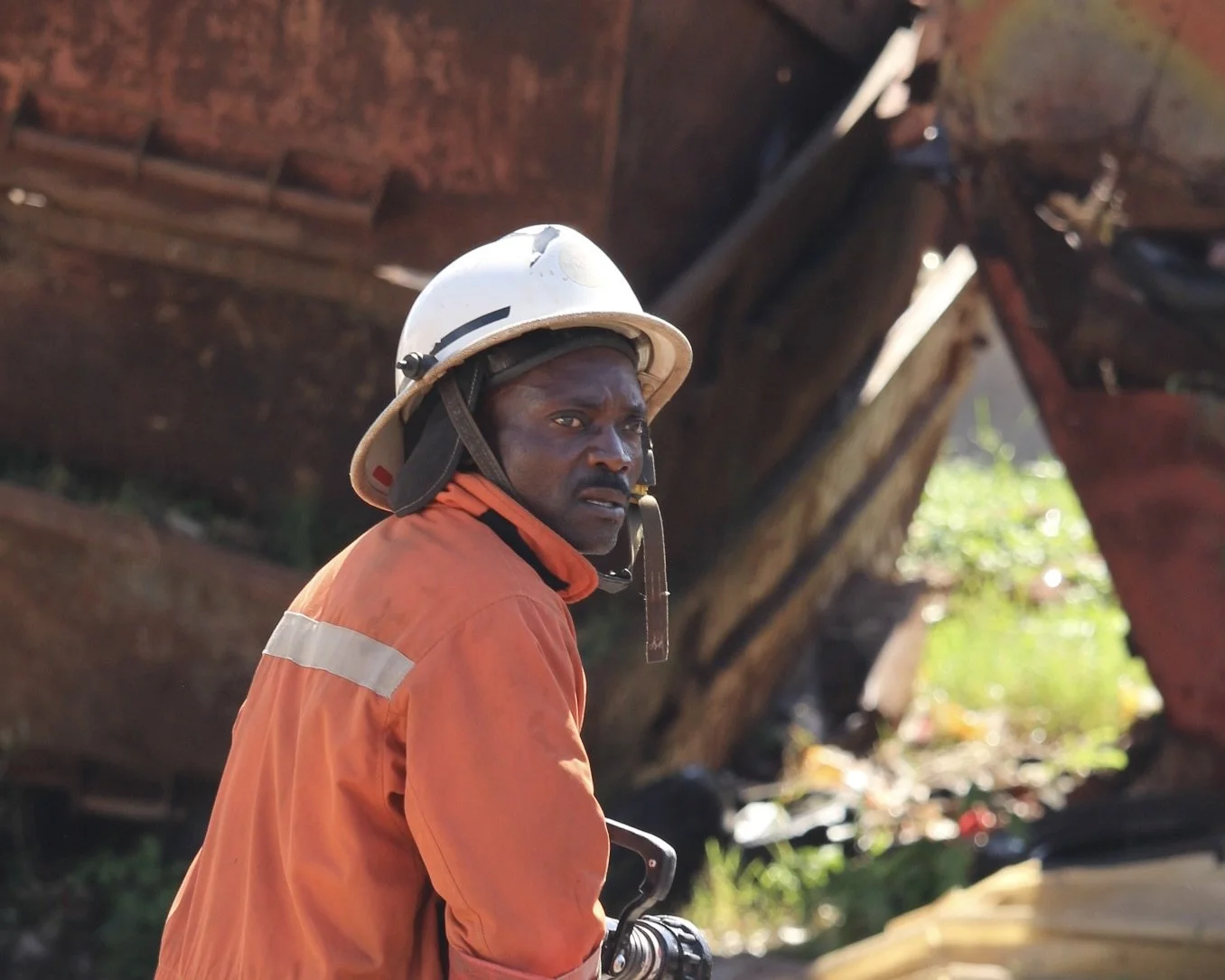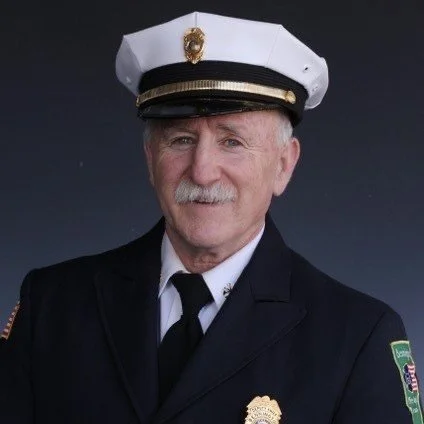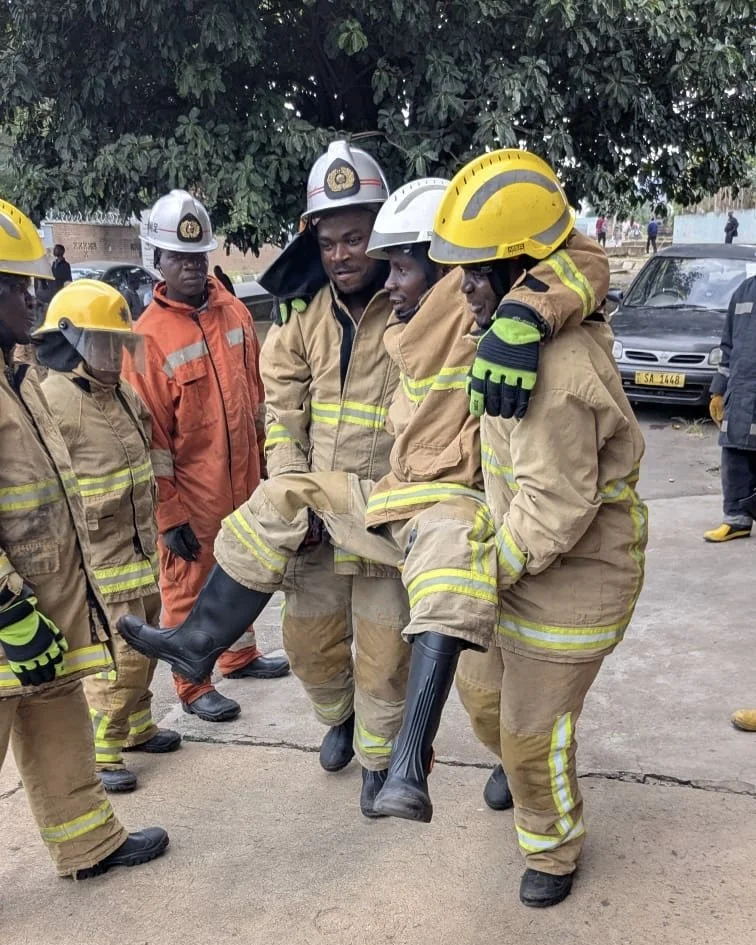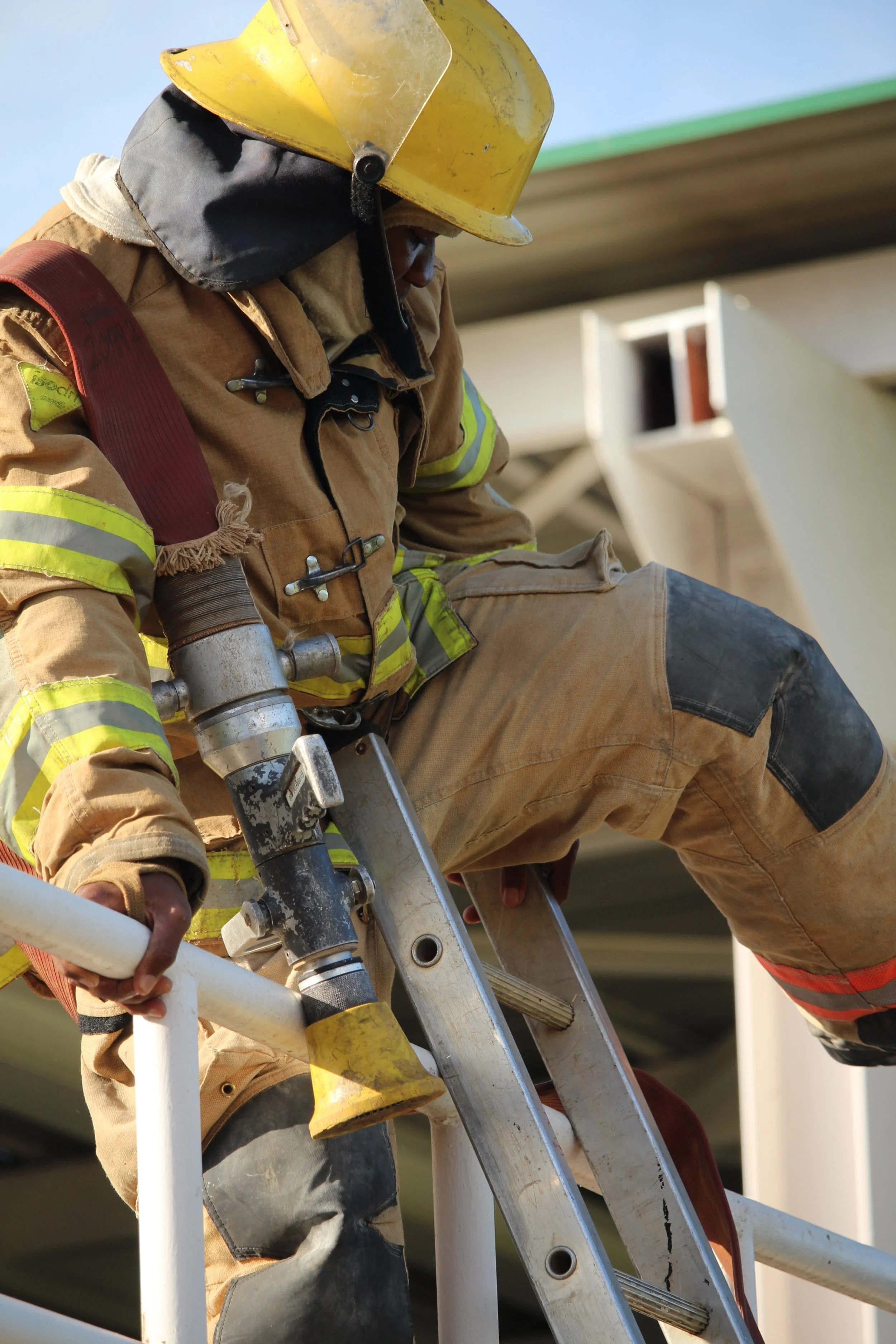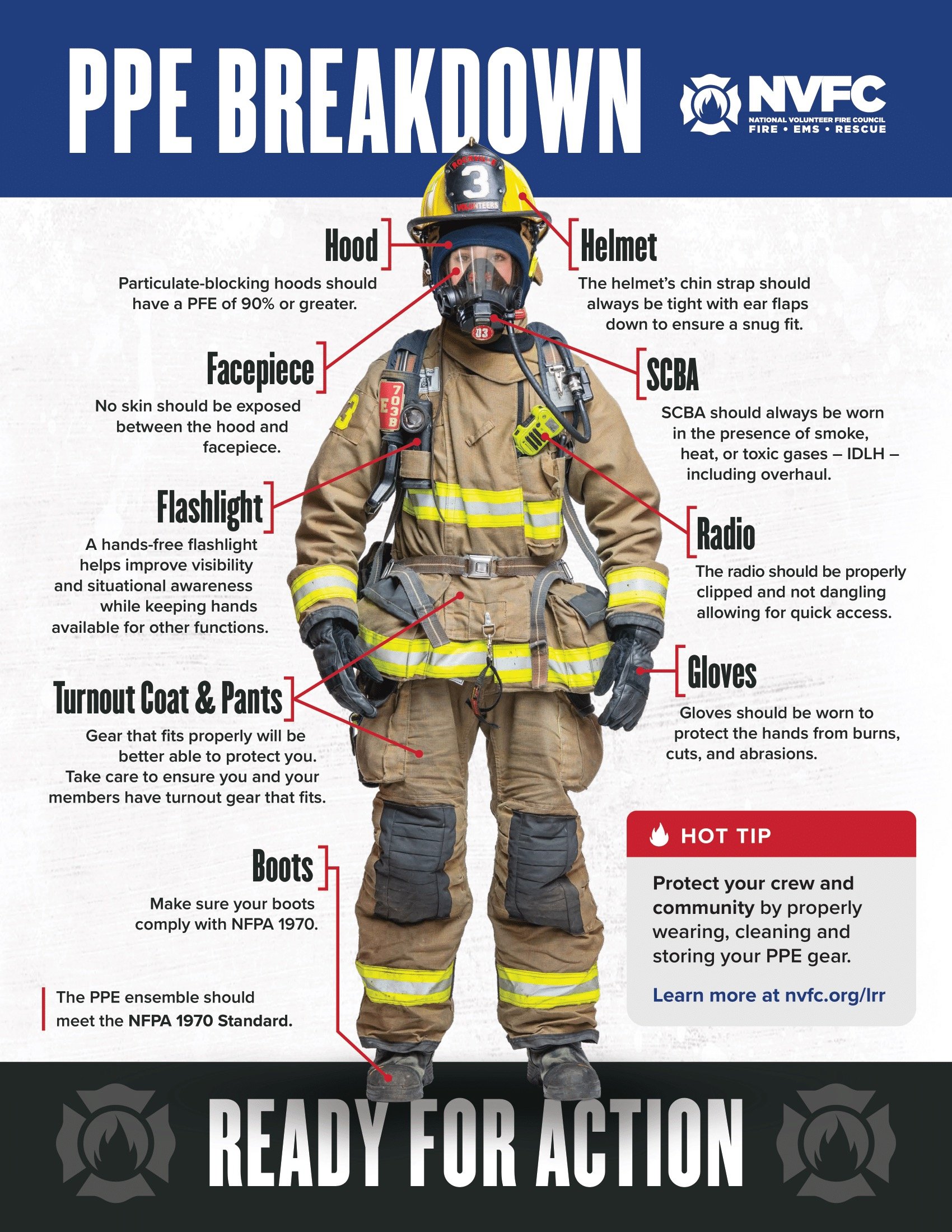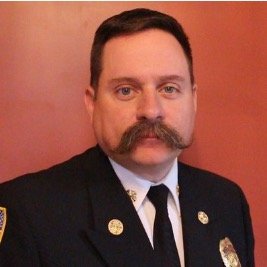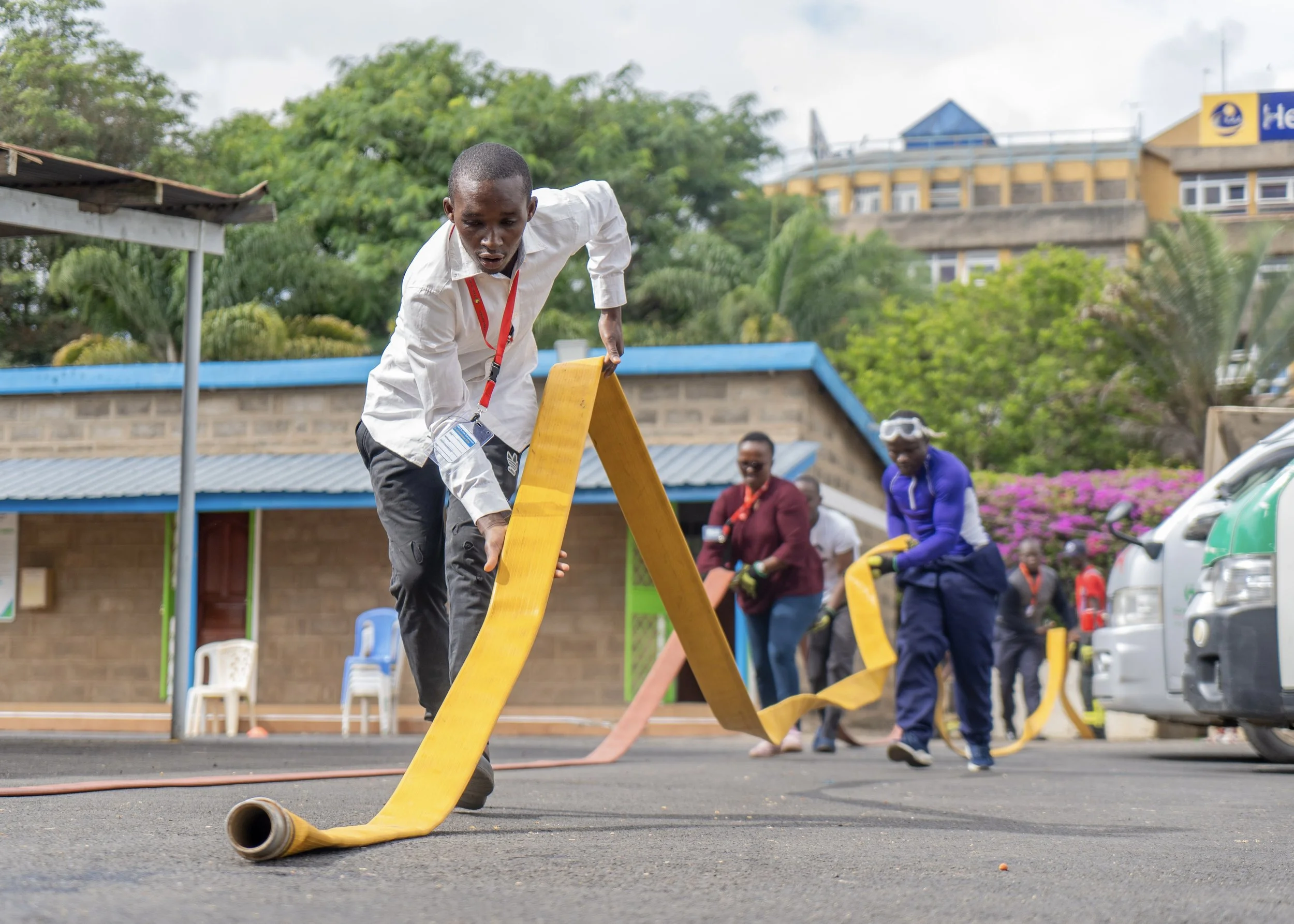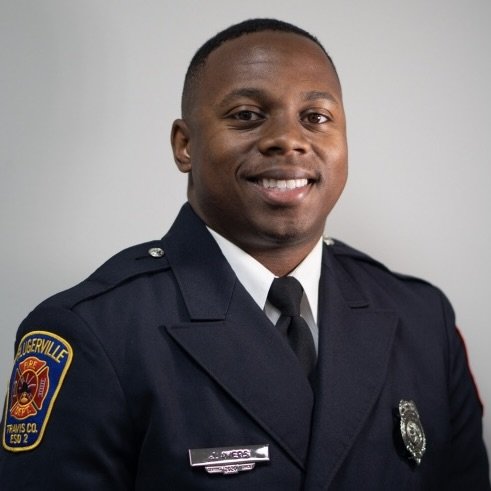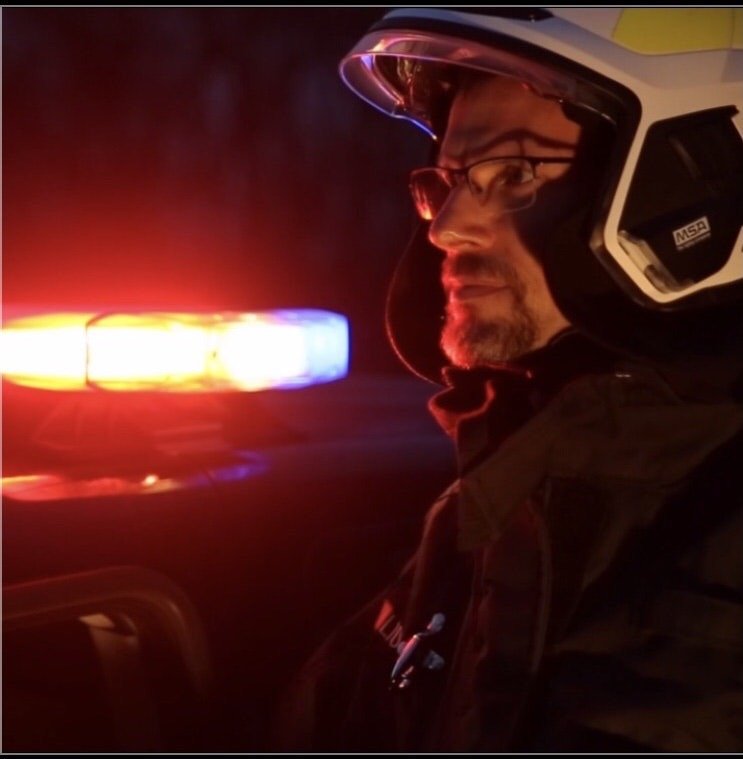We would like to recognize the different award winners from this year’s symposium to highlight the ever-growing fire service in Africa and the determination of first responders in Kenya and beyond.
Gas Cylinder Care
Gas cylinder care is a vital topic in communities that rely on these devices for cooking or other purposes. AFM’s staff team in Kenya, including Fire Safety Officer José Ngunjiri and Fire Safety Advocate Errol Sianga, regularly perform gas cylinder safety lessons in local communities. Now, you can access an official, professional recording of this training on our YouTube page! Whether you are a community member that relies on gas cylinders or you are a fire prevention instructor looking to further your understanding on the topic, please access the video below and watch the full lesson to help prevent deadly fires or explosions from gas cylinders.
Gas Cylinder Care Tips
Before using a gas cylinder, there are two steps you should always keep in mind:
Check the quality of your regulator. It needs to as clean as possible.
Take time connecting the regulator. Check to see if it is leaking or if there is any visible damage.
If a gas cylinder catches fire and starts to get out of control, remember to never throw your gas cylinder under any circumstances. If there is a fire that is starting to get out of control, take a solid, empty bucket and place it on top of the cylinder to create a vacuum, cutting off the air to the fire. Count slowly to five, then carefully remove the bucket away from you and turn off the cylinder. You can also drape a wet blanket and wrap the fire and cylinder completely. Again, count to five, then open it away from you and turn off the cylinder.
Kindly share this post and the video training with your communities to spread awareness on gas cylinder care.
Highlighting the 2025 Kenya EMS & Fire Symposium and Competition
The Impact of Leadership Training on County Fire and EMS Services
“The 2025 Fire and EMS Symposium at Bandari Academy in Mombasa provided an excellent platform for counties across Kenya to strengthen their emergency response capacity. As an instructor in the leadership class, I witnessed the dedication of Kenya’s firefighters and paramedics first-hand and saw the critical need for strong, ethical, and modern leadership within the sector.”
Suleiman Adan Issack, Chief Fire Officer of Mandera County, writes about his experience at the 2025 Kenya Symposium
Fire Scene
The topic Fire Scene carries many connotations or sub-topics. Today’s supporting sub-topics are communication, coordination and control. When utilized consistently, the outcome is most often effective fire scene command. The commander must master and rely on these three skills to support fire and rescue operation efforts whether at single-family dwelling fires or large, commercial incidents.
Firefighter Wellness
by Michael Anderson
Firefighter Wellness can be thought of as the firefighter encompassing their state of health including physical, mental, emotional and spiritual fitness. Firefighters should strive to improve their wellness and work to take steps in each of these areas to improve their lives and serve a very long career.
Fire service organizations have long been investing in the development of resources for fitness and items such as medical screenings. In recent years, more resources have been dedicated to behavioral health to highlight the needs of firefighters to address their mental and emotional fitness. This article will discuss a few of these topics and provide some small steps for individuals to work on their wellness.
Physical fitness:
Firefighting activities require a level of functional performance during response activities. Maintaining a level of fitness is necessary for firefighters and other emergency responders. The physical demands of firefighting along with the working environments require that members develop muscular strength and endurance. This functional fitness should include movements and activities that mimic situations that the firefighter will encounter in their duties.
Stretches, running, and other exercises are very important to a regular and beneficial fitness routine.
Maintaining a level of fitness through cardiovascular and strength training exercises has many benefits. Fitness activities will help firefighters develop muscular strength and endurance, allowing effective use of their equipment and more efficiency on incidents. Fitness helps with fatigue and recovery from strenuous work. The improved range of motion, strength, balance, and coordination also helps prevent injuries of firefighters. Additionally, fitness improves cardiovascular and respiratory system performance. Improvements in these areas both improve performance and overall health.
Medical Evaluations:
Routine medical evaluations are another component of firefighter wellness. Cardiovascular disease and occupational cancers continue to be leading causes of firefighter deaths in the United States. Several medical risk factors have been linked to line of duty death and injuries. The recently revised NFPA 1580 standards provide guidance on the areas to be evaluated during your medical exam.
The benefits of routine medical evaluations can be summed up in one word: detection. Early detection of medical conditions such as high blood pressure, high cholesterol, obesity, diabetes, and others will allow for treatment that can positively impact the risks of firefighters suffering a medical related emergency. Firefighters should take action when faced with increased risk factors from these medical conditions. Treatment for these conditions can reduce the impacts on a firefighter health event.
The increased risk of firefighters to cancer has been identified, recognized, and promoted throughout the fire service. Research has been able to link these increases risks to the exposures that firefighters face during their duties. Cancer screenings are encouraged to be included in your medical evaluation. Early detection and treatment have been shown to improve survival while allowing for reduced costs and less invasive procedures.
Behavioral Health:
The impact of the emotional stress that firefighters face is nothing new to those who serve. Many of us have seen our fellow firefighters experience emotional trauma with various impacts to their lives and careers. Suicides amongst first responders have been increasing at an alarming rate now that reporting mechanisms are in place. Research continues to show that ourselves and our colleagues are plagued by post-traumatic stress and the effects of self-coping activities that many choose to use to deal with these stresses.
A critical step in improving behavioral health is the understanding at the individual level and the organizational level that stress reactions to our job duties are normal. Developing a positive culture around the job stress and supporting members that need assistance can help ensure that mental and emotional fitness can be improved. As an organization, developing programs that look to support firefighters who are suffering from stress can be beneficial on the mental well-being of employees. Programs should look to ensure that members have access to specialized services that understand PTSD, firefighter stressors, alcohol and substance treatment, along with the ability to assist members with other areas of their lives that can impact their mental wellness.
Simple steps towards general wellness:
Maintain levels of functional fitness. Stay active, move often, and work to improve strength and endurance. Push yourself a few days a week and get your heart rate up towards your max heart rate.
Find fun activities with your exercise routine. Adding enjoyable activities to your routine will help you stay motivated in your fitness journey and will help your emotional fitness along the way.
Get an annual medical evaluation. Find a doctor or make an appointment with your physician. Tell them about the dangers firefighter face and ask them to include cancer screenings on a regular basis.
If your examination finds something, take action! Early detection leads to early intervention and vastly improves your ability to reduce your risks of injury or death.
Work hard to sleep well. Evaluate your sleep and find ways to sleep and rest better. Improved sleep can reduce stress and reduce risks.
Understand your stress and attack your stressors. Evaluate the stressors in your life and find ways to reduce how much they impact you. Managing your stress will make you a happier and healthier firefighter.
Find resources for your personal medical and mental health. Resources are available to help you overcome almost anything. Find some and use them when needed.
Physical wellness is key to improving your general wellness!
Taking small and simple steps can have big impacts on your personal and professional life. Begin the journey now and start becoming the best version of you.
Michael Anderson started in the fire service in 1998 as a volunteer in his rural hometown. He has served at Pflugerville Fire Dept. since 2000, currently holding the rank of Deputy Assistant Chief in Administration. With a passion for firefighter health and safety, Michael spent 14 years involved with the NFFF Everyone Goes Home Advocate Program. He has worked with firefighters and organizations across the United States working to improve the health and safety of firefighters. Chief Anderson also serves as an At-Large Director for the IAFC Safety, Health, and Survival Section.
Chief Anderson completed his undergraduate studies in Applied Arts and Sciences from Texas A&M University-Commerce and earned a master’s degree in Public Affairs from the University of Texas- Rio Grande Valley. Michael holds Fire Officer IV, Instructor III, Incident Safety Officer and Health & Safety Officer Certifications. In 2019, he Graduated the NFA Managing Officer program and achieved designation as a Chief Fire Officer from the CPSE Commission for Professional Credentialing in 2023.
Situational Awareness
As firefighters, we face numerous visible and hidden threats both on our way to the fireground and after we arrive. It is important for us to develop our situational awareness skills to help us identify the hazards and minimize risks to ourselves and the public. Furthermore, maintaining situational awareness enhances decision-making under pressure and fosters more effective responses in various situations, such as fighting a fire, rescuing a victim, or driving to a fire scene.
The OODA Loop
The OODA Loop, created by Air Force fighter pilot and military strategist John Boyd, is an excellent decision-making framework that consists of four steps: Observe, Orient, Decide, and Act.
- Observe: This step focuses on what is commonly called situational awareness. It involves making and recording observations.
- Orient: Observations are placed in context to understand the overall situation.
- Decide: Take the results of the orientation and observation steps and formulate the optimal course of action.
- Act: Execute on your decision without delay
The OODA loop helps us remain calm and relaxed during stressful situations, reducing tension and stress and improving everyone's ability to perform their tasks. It is also very helpful for preventing tunnel vision, one of the most dangerous pitfalls on the foreground. Tunnel vision occurs when stress and nerves narrow our focus, causing us to concentrate only on what is immediately in front of us. This lack of peripheral awareness can be deadly.
It is important to develop the habit of instinctively using the OODA loop. Practice it around the firehouse and even at minor calls. As you develop your observation skills, learn to use more than your sight. Paying attention to sounds and smells can teach us crucial fire information.
A firefighter checks his surroundings while training with a firehose.
Communication
Another important situational tool is communication. It is critical that we maintain constant communication with our team on the fireground. We need to inform our commanders and officers of our planned actions. For instance, if a window needs to be broken for ventilation, we must communicate this so that team members below can be aware of any falling glass.
Situational awareness is critical for first responders. We often must make quick decisions in high-pressure, high-stakes environments. By enhancing our situational awareness, we can make more informed decisions that help us stay alert and safe on the fireground.
Howard A. Cohen was a volunteer firefighter for 20 years. He began his firefighting career as a chaplain and retired as the deputy chief. He is currently AFM’s online program content director. He frequently presents for the Wednesday Webinars and contributes to the AFM blog.
An Introduction to the Principles of Emergency First Aid for Firefighters
by Howard Cohen
Not all firefighters are emergency medical technicians or paramedics, but we often serve as the first responders at scenes requiring life-saving first aid. Therefore, it is vital for all firefighters to possess at least a basic understanding of first aid. This short article aims to outline foundational principles for addressing trauma in situations where immediate life-saving medical assistance is needed. This article should not be seen as comprehensive first aid training. Nevertheless, with the basic and limited information provided here, and without any formal training, you may still have the opportunity to save someone’s life.
Scene Survey: The First Task
Size up: Regardless of your level of technical first aid training or medical knowledge, your first task when responding to an incident involving injuries is to gather as much information as possible about the situation. This is achieved through a thorough size up. It is crucial to assess the risks and dangers before rushing in to provide aid. Ask yourself, “What is trying to kill or harm me?” Is it traffic, wildlife, fire, an unstable building, falling objects, or floodwaters? You do not want to become another casualty or cause further harm to the patient.
Number of patients: Once you’ve ensured the scene is safe and stable, it’s time to determine how many individuals are involved in the incident. It’s easy to focus on patients who are crying out in pain and overlook those who are unconscious or not visible. Additionally, it can be tempting to rush to assist a person whose injuries seem more life-threatening than they actually are, such as someone bleeding from a superficial head injury, while another individual nearby has stopped breathing.
Primary Survey: The Second Task
The primary survey is an assessment of the three essential life-supporting functions: the respiratory, circulatory, and nervous systems, often called the ABCDs. Any problems related to these systems present an immediate risk to the patient's life and must be addressed without delay.
ABCDs: Once the size-up is completed, the scene is safe (or as safe as you can make it), and you have a sense of the number of patients needing aid, initiate a primary survey of the patients by checking the status of the three conditions that represent an immediate threat to life.
Airway: Check to make sure that the mouth and airway are cleared and that air is actually going in and out.
Blood is circulating: Ensure that blood is not spilling out and that it is actively circulating.
Disabled: Check whether the spine is stable and the central nervous system is functioning normally. Due to the limited scope of this article, I will not discuss further injuries related to the head, neck, or spine.
Active Bleeding Control Instructor checks the pulse and applies bandages to a patient.
Basic Life Support (BLS)
Basic life support (BLS) is the immediate treatment of one of the three life-threatening emergencies found during your primary survey. Its purpose is to provide temporary support to keep the patient alive while a secondary survey is conducted and/or until advanced treatment is available.
The simplest way to begin a primary survey is to ask the patient, “How are you?” If he answers, you know that his airway is not obstructed (A), his heart is beating (B & C), and his brain is functioning (D). If the patient does not respond or responds in an unusual way, you will need to look more closely.
Airway:
Airway problems result from an obstruction to the pharynx or larynx, which can be complete or partial. A complete obstruction is rapidly fatal, but it can be effectively and dramatically treated by clearing the airway. There are various ways an airway can become obstructed, such as vomit, a foreign object, swelling caused by trauma, an irritant, or an allergic reaction. It is imperative that you clear the airway, but you must do so without causing any additional harm to the patient.
Breathing:
A person can have an open airway yet still experience difficulty breathing. This may result from an injury to the brain, spinal cord, or diaphragm. The method for assisting a patient with breathing when more advanced medical care is unavailable is known as positive pressure ventilation or artificial respiration (mouth-to-mouth). The inflation rate should be around 12 breaths per minute or one every 5 seconds, with each breath lasting about 1 to 1.5 seconds. Rapid breaths can push air into the stomach, potentially leading to vomiting.
Bleeding & Circulation:
Uninterrupted blood circulation is essential for survival. There are two primary types of disruptions to blood circulation that a first responder can address: cardiac arrest and bleeding. Cardiac arrest occurs when the heart stops beating. During your primary survey, if you discover that the patient has no pulse, it indicates that her heart has stopped beating, and she is in cardiac arrest. It's important to note that in adverse situations, or if the patient is in shock, finding a pulse can be challenging. The carotid pulse is the strongest and easiest to access; it is located on either side of the larynx in the neck. If there is no carotid pulse, the heart is not beating. CPR (cardiopulmonary resuscitation) is the only treatment for cardiac arrest. Even with hands-on training, it has limited potential to restore and sustain life.
The second type of disruption to circulation results from significant blood loss. Controlling blood loss is essential as part of BLS. Bleeding can be internal, which is often difficult to identify and stop, or external, though it may not always be obvious. Addressing internal bleeding goes beyond the scope of this article and the capabilities of most first responders in the field. External bleeding is managed by applying direct pressure to the bleeding site with your hand, ideally using a cloth or bandage. This application is not intended to absorb the blood; instead, it provides uniform pressure across the wound. Prepare to maintain direct pressure for ten minutes or more. If the bleeding does not stop, remove the bandage to locate the source of the blood and then reposition your hand.
There is no easy rule for determining when bleeding is severe. A rule of thumb is that if it looks like a lot of blood, it probably is. However, severe bleeding can be missed if the patient is wearing a lot of clothing or the blood is absorbed into the ground around the patient.
Conclusion:
Firefighters practice safely transporting an injured person.
When developing first aid skills, like all skills a firefighter must master, training and practice are essential. Additionally, reading about the principles and theories that support these skills is important. However, there is no substitute for training and practice.
For more information, visit the following references:
Africa Fire Mission Active Bleeding Control Resources
The Outward Bound Wilderness First-Aid Handbook; Jeff Isaac & Peter Goth.
The Field Guide of Wilderness & Rescue Medicine; Jim Morrissey & David Johnson.
Opening an Unconscious Patient’s Airway with a Manual Manipulation
Howard A. Cohen was a volunteer firefighter for 20 years. He began his firefighting career as a chaplain and retired as the deputy chief. He is currently AFM’s online program content director. He frequently presents for the Weekly Virtual Firefighter Trainings and contributes to the AFM blog.
Fireground Tactics
by F. R. Montes de Oca
Initial arrival at a fire often poses several simultaneous challenges for the officer to address rapidly. Utilizing the Rule of 3 can help the incident commander to develop a tactical posture. They are:
1. What do I have?
2. Where is it going?
3. What do I need?
The first question (What do I have?) addresses:
The terrain of an incident location or layout of a building can impact the tactics you should use.
What is the building used for? Living? Storage? Manufacturing?
Is it a single or multiple-family dwelling?
Are there victims? If so, how many? Are they exiting on their own?
What is the square footage and how many stories?
Are additional occupants still in the structure who need help to exit?
Similar questions can be asked for a vehicle fire: size (single, multi-vehicle or public transit vehicle. Victims out or entrapped?
The second question (Where is it going?) forces you to think about the possibility of spread:
Do I have exposures? Is high heat or high winds affecting fire spread?
Can I ignore the exposures and focus on the primary body of fire?
Will I need additional resources for fire progression AND exposures?
Must I focus all resources to rescue occupants?
Focusing on egress pathways for building occupants is imperative. Often-times with limited resources tactics must be focused solely on rescuing or assisting occupants exit the structure.
The third question (What do I need?) is based on what is discovered or decided upon by answering the first two questions. What resources needed implies deciding whether hoselines are applied directly initially or are supply lines needed – or must victim rescue be my first tactic?
The situation is often complicated by the fire rapidly spreading due to high winds or multiple victims needing rescue. When this occurs, tactics will change quickly from suppression to rescue.
While the tactics may address the initial and additional challenges, it is important to remain cognizant of additional aspects to ensure an effective fireground operation:
Communications, which is the critical conduit of incident management. All on-scene and responding members must be apprised of the current situation and have a clear understanding of their assignments.
Rehabbing responders operating on scene is one of the most important actions the Incident Commander can ensure occurs. Ensuring that members take a short break every 15 minutes or so will allow crew viability and increased scene effectiveness.
Incident Safety should be the overarching effort all scene commanders should undertake. Whether on scene at a structure fire, complex vehicular accident or hazardous materials incidents maintaining the safety and well-being of responders is imperative.
If formally assigned Safety Officers are not part of the department, it is advisable to appoint someone on scene whose only function is observing operations to ensure the safety and welfare of all firefighters. Whenever possible, the individual assigned the task should possess a mix of experience and formalized safety training.
At your next emergency incident pose the three questions to assist you in developing effective tactical decisions.
In closing, Incident command truisms that help officers maintain a sharper eye on effective tactical decision-making:
When a tactic is not working, change the tactic.
No matter how good your plan is, have a backup plan.
Frank Montes de Oca served as a firefighter/paramedic for over 38 years attaining positions as Chief of EMS, Training Bureau Commander, and Chief of Department. He remains engaged in managing and developing firefighter safety programs and mentoring leaders.
Successes and Updates on AFM's Active Bleeding Control Program
Africa Fire Mission (AFM), in collaboration with its international research and implementation partners, received support from the Laerdal Foundation to launch Active Bleeding Control (ABC): A Pilot Life-Saving First Aid Program in Sub-Saharan Africa. The project aims to reduce death and disability from life-threatening bleeding in Sub-Saharan Africa through contextualized training for first responders and community members. This includes a focus on reducing deaths from life-threatening bleeding in high-risk road traffic accident corridors in Nairobi. This was the first year of a three-year grant and we were able to make significant progress with implementing a contextualized program for Sub-Saharan Africa.
Volunteers participating in ABC training.
Our goal for the training of trainers was to create a replication model for training. Since the end of March 2025, volunteer instructors have trained more than 790 individuals. The training has already been conducted across two countries (Kenya and Malawi) and eight cities/ counties (Figure 3). This training equips community members with critical skills to stop lifethreatening bleeding. Participants in the Active Bleeding Control trainings come from diverse backgrounds, including transit workers, workers in the hospitality industry, students, community health promoters, public health officers, teachers, church groups, museum staff, firefighters and EMTs. Interest in the program is growing, and replication of the training is gaining momentum as our instructors actively engage with their communities. We are now over halfway to our goal of training more than 1,000 individuals in life-saving active bleeding control techniques and are actively developing strategies to expand training access for transportation personnel.
These successes highlight the need for this program and the success of our replication modelfor training. Contextualizing the Active Bleeding Control (ABC) curriculum for the Sub-Saharan African context has proven essential to the program’s acceptance and effectiveness. Our focus groups highlighted that cultural norms in many communities discourage bystander involvement in emergencies, often due to fear of legal consequences, misunderstandings about disease transmission, or social taboos around touching blood or injured persons. In some cases, people are explicitly advised not to help, out of concern for personal liability orsuperstition. Additionally, limited awareness about basic first aid practices andmisconceptions about bleeding injuries can lead to harmful delays in care. By adapting training materials to reflect local language, beliefs, and lived experiences—and by incorporating trusted community voices—we are addressing these barriers and fostering anew culture of empowered, informed responders within the community.
Empowering trainers to volunteer their time to impact their communities has also proven tobe a successful model fostering increased buy-in as well as long-term commitment for sustainability and growth of the training program.
Interested in learning more? Read our full report below:
PFAS and Firefighters in Africa
by Mike Kull
Recently there has been discussion throughout the Fire Service about the presence of and exposure to PFAS for firefighters. PFAS (per- and poly-fluoroalkyl substances) are a man-made class of thousands of “forever chemicals” that do not break down in the environment, are highly mobile, and can accumulate in the body and cause disease.
Firefighters are exposed to these chemicals several ways:
Smoke and Soot from Fires
AFFF (Aqueous Film Forming Foam) Firefighting Foam
Dust, Dirt and Debris around the Fire Station
Firefighter Turnout Gear (PPE or Personal Protective Equipment)
There are many ways to try to reduce exposure to these hazardous chemicals. Firefighters should always wear a complete PPE ensemble (Tunic, trousers, boots, gloves, hood, helmet and BA) when exposed to smoke from fires containing any man-made products. This PPE should be properly cleaned after each exposure to smoke and soot. Care should be taken when removing this contaminated gear and firefighters should thoroughly clean and shower themselves after each incident involving smoke and soot. Fire Brigades should evaluate the type and use of AFFF foam. AFFF should not be used for training, exposure should be limited, and everything exposed should be flushed with clean water. Care should be taken while cleaning the Fire Station and equipment to limit exposure to dust and soot from fires.
These are all practices that have been implemented throughout the world to limit exposure to harmful chemicals. Another exposure comes from PPE itself. Research has shown that most firefighter PPE is treated with some of these “forever chemicals.” The equipment is treated with these chemicals to meet standards and requirements for the performance and manufacture of firefighting PPE. These chemicals may be used to increase resistance to flames and provide waterproofing in the equipment. Firefighters can be exposed to these chemicals through absorption through the skin.
The exposure to these chemicals from firefighting PPE poses a special problem for many firefighters in Africa. In other parts of the world, Fire Brigades are changing policies and procedures and procuring alternate equipment to reduce this exposure. The equipment containing these chemicals is only being used for incidents involving fire. For many African firefighters, turnout gear is worn all the time. Many firefighters do not have uniforms, and the turnout gear is worn as if it were a uniform. Many firefighters don’t have access to alternate forms of PPE that do not contain these chemicals so wearing a different type of PPE is not an option.
Summary:
Firefighters need to be aware of the hazard of being exposed to PFAS.
Firefighters need to take steps to limit their exposure to these chemicals.
Firefighters need to find a balance between reducing exposure to hazards and appropriately serving their communities.
Firefighters should explore other options for identifying themselves with uniforms instead of PPE.
Firefighters should only wear turnout gear to achieve a specific purpose such as training, responding to emergencies and increasing community sensitization.
After wearing turnout gear, firefighters should maintain the highest levels of personal cleanliness and hygiene.
For more information, visit the following pages:
Mike began serving as a volunteer with AFM in 2021. After his first trip to Kenya, he committed himself to serving the firefighters in Africa and has been volunteering with AFM ever since, and now works as Programs Director. Mike has worked in all aspects of Public Safety since 1998. He served 17 years as Fire Chief in Valley Township, Pennsylvania and also as a Forest Fire Warden for the Commonwealth of Pennsylvania. He has a background in law enforcement, EMS and the fire service, as well as politics, having served as a local elected official. Mike has a BS in Administration of Justice from the Pennsylvania State University, where he met his wife Jody. They reside in Bellefonte, Pennsylvania with their son Gunther.
Safety Versus Security: Can We Have Both?
by Jerry Bennett
During our fire training and prevention trips, one cannot help but notice the heavy security gates and bars protecting homes and businesses across Africa. Physical security is a necessary part of life regardless of where you live and work. Most of the world has cities and neighborhoods with heavy security measures such as padlocks, deadbolts, and security bars on windows and doors to prevent theft and vandalism, for good reason. Thieves will break in and steal or cause harm. At the same time, as homeowners and firefighters, we know that locks and bars designed to protect us from wrongdoers on the outside may also prevent us from fleeing danger inside our homes, especially fire and smoke. So, we must consider both risks: keeping bad people out whilst being able to escape quickly during a fire or other emergency.
The last fatal fire I responded to before retiring was a twelve-year-old boy. While he was sleeping, a blanket came in contact with a space heater and started a fire in his home. His parents had left for work and locked the children inside using a double-cylinder deadbolt (which requires a key to enter or exit). Unable to escape without the key, the boy hid in a closet and died of smoke inhalation. While double-cylinder deadbolts are less common in American homes, most homes and dormitories I have visited in Africa require a key to exit from the inside when the door is locked, usually unlocking a padlock.
Firefighters train fighting fires with a large wall as an obstacle.
So what can be done? As household leaders, consider your escape plan for your own home. If all windows and doors have security bars, could a modification be made to allow the bars to swing out after unlocking a mechanism with a key? This could be especially important in a two-story home where everyone sleeps upstairs and a fire starts in the kitchen below, preventing exit through normal means. If your home has one or more gates locked with a key, who has access to the keys, and where are they kept? Each family must make these decisions intentionally considering the possibility of fire even when parents are away from home. Consider these issues for other homes and businesses when conducting safety evaluations. Raising these concerns with home and business owners may cause them to devise creative solutions to balance security and safety.
Jerry Bennett is a retired District Fire Chief from Illinois. He joined the AFM team in 2021 and has participated in several Mission Trips. Today, he is a member of our Board of Directors and assists AFM in planning and training.
Advancements in Mombasa's Fire Department
by Ibrahim Basafar
My name is Ibrahim Basafar, and I serve as the County Chief Fire Officer for the Mombasa County Government. I am also a PhD finalist in Law Enforcement and Legal Justice Systems at Mount Kenya University.
I recall joining the fire department from the Inspectorate department when His Excellency Abdulswamad Shariff Nassir was elected as the Governor of Mombasa County.
During a visit to the main fire station in October 2022, I was quite surprised by the conditions. There was no dedicated CFO office, recreation center, or classroom. The dormitories were in poor condition, infested with bed bugs, and lacked basic amenities like paint or fans.
The station was operating with only one functional fire engine with an unstable and leaking tank. Additionally, there were broken and leaking fire water hoses, no FFF foam, no allocated fuel, and a lack of essential protective gear such as fire tunics and breathing apparatus. There was also no established curriculum, control room, OB facility, or operational system in place. Sadly, the station had become known as a place to transfer officers with disciplinary issues from other departments.
Governor Nassir and I agreed that the fire department had been neglected and needed a complete transformation into a model department for other county and national entities to learn from. Our initial focus was on enhancing the capacity and discipline of our officers. Following this, we successfully increased the annual budget allocation for the fire department.
Today, we have 102 fire officers who have received comprehensive training in firefighting techniques, OSHA standards, first aid, and water rescue, along with internal supervisory training. Mombasa now has an Emergency Operation Center, overseen by a Fire Officer, which manages county-wide disaster and emergency responses. We have five operational fire engines and one rescue truck equipped with all necessary tools, including extraction equipment for road traffic accidents. All dormitories have been renovated, and the three main stations in Likoni, Changamwe, and Mvita have been refurbished to meet a standard fire department aesthetic.
Currently, we have 60 new, UK-standard fire tunic suits acquired by the county (not donated), 54 self-contained breathing apparatuses, UK-standard fire water hoses with branch nozzles, and a storage of 10,000 liters of AFFF foam. Continuous daily classes are conducted in all three stations using a standardized fire curriculum. Furthermore, a new fire station in Kiembeni is nearing completion at 85% and is expected to be fully operational by June 2025.
We have also extended our training to other counties and institutions, including 60 officers from Kiambu County Fire, 40 from Nairobi, 98 from Tana River (including Chief Wako), 300 individuals from various universities and colleges, and 220 ongoing trainees at the Mombasa Inspectorate school. In 2024, we conducted 52 school inspections and training sessions, as well as 50 community awareness programs.
Presently, 50% of our officers are fully equipped with standard fire tunic suits, boots, helmets, self-contained breathing apparatuses, and working uniforms.
With the continued support of His Excellency Abdulswamad Shariff Nassir, we are optimistic about achieving 100% PPE for the remaining officers in the next financial year. We also aim to build an additional fire station in Nyali, initiate a kitchen welfare program for our firefighters, and implement promotions for the existing force.
It truly makes our day when our firefighters return home safely with a sense of accomplishment.
Chief Fire Officer Ibrahim Basafar is Mombasa County Government’s Fire Chief. He is a PhD Finalist in Law Enforcement and Legal Justice Systems at Mount Kenya University. He is an experienced Fire Officer and safety expert.
“It’s incredible to see the advocacy and advancement taking place in the fire service in Mombassa. Collaboration, relationships, advocacy, and tenacity have been required to improve Mombassa’s fire service. We hope that other fire services in Africa can learn from what Mombassa is doing!”
- Nancy Moore, Africa Fire Mission, Executive Director
The Value of a Quality Personal Protective Equipment Program
The Value of a Quality Personal Protective Equipment Program (PPE)
Executive Summary
Over the past decade, Africa Fire Mission's engagement with Firefighters across Africa has underscored a critical need for a Personal Protective Equipment (PPE) program. This engagement reveals a troubling trend: Firefighters often use outdated, damaged, and non-compliant PPE. Examples include PPE failing to meet international standards (National Fire Protection Association (NFPA) or European Standards (EN)) exposing Firefighters to severe hazards due to equipment that is flammable and inadequate. The issue of Firefighters operating in inadequate PPE, from street clothes to substandard boots and gloves, highlights a gap in safety standards. This paper advocates for a comprehensive PPE program encompassing adherence to international standards, proper training, and stringent maintenance practices. Implementing such a program will enhance firefighter safety and also ensure operational effectiveness in the face of life-threatening situations. Key components of this program include choosing a recognized standard to follow, acquiring compliant PPE, conducting regular training on PPE use and maintenance, and establishing oversight and documentation systems to support ongoing PPE use, care, maintenance and replacement.
Firefighter Physical Fitness
by Howard Cohen
Firefighting is a dangerous and physically demanding job. Firefighters operate in harsh and challenging environments, use heavy, hard-to-handle tools, and wear many kilos of protective gear. We need to keep ourselves in great shape to do our jobs. This means we must care for ourselves through proper nutrition and hydration, physical exercise, and sufficient rest. This is what is minimally required to properly and safely perform our jobs.
If you stop and think about it, what is the one “tool” every firefighter uses at every call? It’s our body. We depend on our bodies for all aspects of firefighting. In this sense, firefighters are like elite athletes. While we may not have to jump, sprint, or throw a ball, we are often required to crawl, drag, or haul awkwardly shaped heavy objects in extreme heat conditions that greatly tax our cardiovascular systems. But there are important differences too. Elite athletes generally perform under optimal conditions. Firefighters respond to calls during the worst weather conditions. Elite athletes typically get a good night’s sleep before their big events. First responders are often woken up multiple times during the night. Elite athletes eat a well-balanced meal with regard to their upcoming sporting event. First responders' meals are often rushed, gobbled on the run, or interrupted by calls. However, the biggest difference is that it is all about winning or losing for elite athletes. What’s on the line for firefighters is often life or death; yours, your fellow firefighters, or a civilian’s.
The good news is that achieving a firefighter's operational level of physical fitness is not hard. However, it does require a commitment to exercise regularly. There are many great ways to hone your fitness level. If you can access YouTube, search for a type of workout that appeals to you. You will discover many free options to choose from. Ideally, your workouts will include strength training with weights or whatever heavy objects you have available to you and cardiovascular exercises, such as lunges, jumping jacks, running, climbing stairs, or any activity that gets your heart rate up. You don’t need a specific or fancy program to get in good workouts. All you need is to make a personal commitment to move your body and get your heart pumping. Any well-rounded program will benefit you in all aspects of fitness.
A good workout routine for first responders ideally includes four types of exercises.
1) Active movement exercises
2) Strength building
3) HiiT: High Intensity Interval Training
4) Deadlifts
Active movement: Exercises such as Bear Crawls, Mountain Climbers, or Spider Lunges engage nearly every muscle group and build core and cardiovascular strength and agility. Their primary purpose is to improve mobility.
Strength Building (Dumbbells): If you have them, dumbbells are preferable to barbells for first responder strength training because they allow for a greater range of motion and enhance overall muscle stabilization and activation. Dumbbells also help identify and eliminate strength imbalances by forcing the limbs to work unilaterally. If one side is significantly weaker than the other, there's no way to compensate. They are safer to use if you are working out alone. Finally, there is no limit to how you can use them in your workout.
HiiT: High-Intensity Interval Training: HiiT workouts consist of bursts of intense activity followed by short rest periods. They provide the most benefits in the least amount of time. The advantages of HiiT workouts include burning calories quickly, improving cardiovascular health, and enhancing metabolic function. Additionally, a HiiT workout increases muscle mass and effectively improves overall fitness levels.
Deadlifts: There is a tendency to think that deadlifts are just when you bend over and lift a heavy weight. In fact, there are many variations of the deadlift. They include squats, lunges, single leg deadlifts, suitcase squats and farmer walks. All are excellent exercises for building stronger Legs, core grip, and lower back strength.
There are no downsides to exercising and being physically fit. Physical fitness has been shown to prevent or treat various chronic health conditions resulting from unhealthy lifestyles, and it even counters certain aspects of the aging process. Studies indicate that regular exercise strengthens the heart and, when combined with a healthy diet, can reduce the risk of cancer and enhance the immune system. Being physically fit also helps lower the risk of injuries that can hinder your ability to work. Sometimes, firefighters overlook that physical fitness involves more than just working out; it also requires taking care of your body through proper nutrition, staying hydrated, getting enough sleep, and avoiding or limiting harmful substances like alcohol, recreational drugs, or tobacco.
The biggest obstacle to sticking with a fitness plan is boredom. Therefore, it is important for you to find or create a routine that holds your interest. Mix it up too. Don’t do the same workout day after day. Work out with a friend or your other brigade crew members. Make it fun. To the extent your schedule permits, making your fitness program a fixed and regular part of your daily routine is also helpful. Some people like to get their workouts in early in the morning. This way, no matter how the rest of the day unfolds, it’s a good day because you got your workout in. Other people like to work out at the end of the day. This way, they figure they have something to look forward to no matter what kind of day they are having. I get my workout in every morning after having two cups of black tea and reading the headlines in the paper. After my workout, I’m ready for whatever is coming my way.
In conclusion, this article aims to inspire you to find and commit to a personal fitness program that excites and motivates you. Honor your body—after all, it is the home of your holy soul. Now get moving and get your heart pumping!
If you want to learn more about fitness training for first responders, I recommend this article. If you would like to learn more about cancer prevention for firefighters, read this recent AFM blog post.
Howard A. Cohen was a volunteer firefighter for 20 years. He began his firefighting career as a chaplain and retired as the deputy chief. He is currently AFM’s online program content director. He frequently presents for the weekly virtual trainings and contributes to the AFM blog.
Cancer Prevention for Firefighters: A Vital Mission
Firefighters face unique and significant health risks due to their exposure to hazardous materials during their duties. Understanding these risks and implementing effective prevention strategies are crucial for promoting firefighter health and well-being.
Understanding Cancer Risks
Firefighters are regularly exposed to hazardous substances like benzene and formaldehyde, which can lead to serious health issues, including various cancers. The increased cancer risks make awareness and understanding essential for protecting firefighters' health.
Prevention Strategies
Employing effective prevention strategies can significantly reduce the cancer risks firefighters face during their careers. Key strategies include:
Use of Personal Protective Equipment (PPE): Wearing appropriate PPE is essential for minimizing exposure to harmful substances during firefighting. Regular maintenance of PPE ensures its effectiveness and keeps firefighters safe from hazards.
Health Monitoring Programs: Regular health screenings and monitoring programs can help detect early signs of cancer in firefighters, promoting timely intervention.
Training in Hazard Awareness: Providing training on hazard awareness helps firefighters recognize and mitigate risks associated with harmful exposures.
Wellness Practices
Promoting wellness practices among firefighters can enhance their overall health and well-being, mitigating health risks. Key wellness practices include:
Healthy Lifestyle Choices: Adopting a balanced diet, engaging in regular exercise, and getting adequate rest are essential for maintaining good health and a strong immune system.
Stress Management Techniques: Incorporating stress management techniques like mindfulness and relaxation can greatly benefit firefighters' mental well-being.
Regular Health Screenings: Early detection of potential health issues through regular screenings can significantly improve treatment outcomes.
No matter what your position in the emergency services is, it is important to keep your health in mind!
Conclusion
Firefighters face unique cancer risks due to exposure to hazardous materials. Awareness, effective prevention strategies, and wellness practices are key to reducing these risks and promoting firefighter health. By prioritizing these measures, we can ensure the safety and well-being of those who bravely protect our communities.
James Nyadwe is a Water Survival/Safety Expert and Trainer, Open Water Scuba Diver, and a Fire Advocate. James is passionate about sharing knowledge on safety issues on land and water that impact first responders. Additionally, James has served as an instructor for AFM’s virtual firefighter training.
LION Grant Impacts AFM’s Growth - Meet Errol!
Because of LION’s renewed and ongoing commitment to our programs, AFM is pleased to announce that we now have a second team member to work full-time in Africa! Errol Sianga is our newest team member. Based in Kenya, Errol has worked in communities and made a difference over the years as a Fire Safety Advocate Volunteer. He is well equipped to provide hands-on instruction and assist AFM with training, empowering, supporting, and encouraging communities across Africa.
Leadership Training in Kenya
The 2024 All Kenya EMS and Fire Symposium held at Jomo Kenyatta International Airport, Nairobi, Kenya integrated several fields of training. Fire Prevention, Health and Wellness, Firefighting Tactics, Emergency Medicine, and Leadership were all incorporated topics. AFM team member Tim Baker writes about his experience as a leadership instructor!
Department Standardized Training
by Jeremy Ayers
It is often heard that fire departments operate differently across shifts and stations. This variation arises from differences in managerial styles and the emphasis placed on training. While diverse leadership styles can be beneficial, as they bring unique experiences and perspectives that help tackle various challenges, consistency in certain areas is crucial—particularly in training. Standardized training ensures minimal gaps in capabilities between shifts, fostering operational efficiency, and safety.
In the face of national challenges in recruiting and retaining firefighters, many departments are increasingly relying on overtime. This trend exacerbates capability gaps since different crews may prioritize distinct areas of training. When overtime personnel are assigned to shifts, they often have not trained with the regular crew throughout the year. This creates a significant challenge for company officers, who cannot feasibly address all high-risk, low-frequency scenarios during a single shift with temporary personnel.
Standardized training can help departments work together better.
Training and education are the foundation of the fire service. Therefore, it is imperative for departments to communicate a unified training agenda that ensures all personnel receive consistent, high-quality instruction. To address this need, the Pflugerville Fire Department (Travis County ESD2) has prioritized high-risk, low-frequency training by forming specialized training teams. These teams undergo advanced training throughout the year and deliver that knowledge to the entire department. They achieve this by visiting stations, conducting multi-company scenarios, or providing materials for officers to facilitate training sessions.
These specialized training programs cover essential topics such as vehicle rescue, swift water rescue, technical rescue, and Vent-Enter-Isolate-Search (VEIS). The key benefit of this approach is that all personnel, regardless of shift or station, receive the same foundational training annually. This consistency has led to notable success stories, demonstrating the positive impact of these initiatives on community safety.
One such example occurred late one night around 1:00 a.m., when the department was dispatched to a structure fire with a victim visibly trapped and hanging out of a window. The unit was recognized for its rapid rescue, with it only taking a few minutes from arrival to rescue the victim from a third-floor window without delays.
The truck was staffed with a lieutenant acting as captain, a probationary firefighter, a senior driver, and a relatively new firefighter. Remarkably, half of the crew members were from different shifts or stations. Despite this, they performed cohesively and at a high level, throwing a ladder to the third floor, masking up, and safely removing a victim from the window. This underscores the importance of VEIS training, which equipped all crew members with recent, standardized skills to handle such critical situations. Members were presented with similar training months before the incident occurred that outlined comparable rescue conditions.
Standardized training can help difficult emergency responses, like rescue operations, easier.
From the community’s perspective, firefighters are seen as a unified team ready to address emergencies, regardless of their individual roles or experience levels. For example, the probationary firefighter performed at a high level, and anyone observing from the outside would not have been able to tell he was the newest firefighter because of his prompt critical decision-making. To meet these expectations, firefighters must train rigorously and prepare for high-risk scenarios.
Jeremy Ayers is an Apparatus Specialist with the Pflugerville Fire Department (Travis County ESD2), where he has proudly served since 2020. Pflugerville Fire Department is a career agency serving approximately 150,000 residents with eight stations and responding to around 14,000 calls annually.
Additionally, he actively contributes to the department’s recruiting, mentorship, peer support, and honor guard team. Jeremy is an advocate for the National Fallen Firefighters Foundation.
Jeremy holds a Fire Officer designation from the Center for Public Safety Excellence and an associate’s degree in Fire Protection Technology from Austin Community College. Jeremy earned his bachelor’s degree in Organizational Leadership from Texas A&M Commerce and his Master’s degree in Public Affairs with a concentration in Public Administration from the University of Texas Rio Grande Valley.
Bush Fires
by Brad Fiore
Just like any other fire, there are two main strategies in fighting bush fires: Direct and indirect. Topography, fuel types, and resources may vary between the US and Africa, but the basic tactics are the same. In a direct attack, we remove either the oxygen or the heat, and in an indirect attack, we remove the fuel.
The best tool we have for fire extinguishment is water. Unfortunately, a lot of times, the fire is in an area that makes it difficult to get water to. Hand tools play a significant role in fighting bush fires. The basic types are cutting, digging, scraping, and smothering tools.
In a direct attack removing the oxygen is accomplished by smothering the fire. We can throw dirt on the burning material or pat small flames out with our tool. I’ve seen fire flappers used to beat the flames of large bushes. I am not familiar with how well this works, but from another point of view, in North America, our flappers are smaller, and we use them on small creeping fires. The technique is to drag the flapper over the burning material, maybe using a slight patting motion. Beating a fire uses a lot of energy in one concentrated area. It also seems that embers are kicked up into the air, which could start a spot fire. Other tools, such as hoes and fire rakes, can all be used to pat out small flames.
Smoke coming from trees can be a sign of a potential bush fire.
When you use water to remove the heat, use it sparingly and wisely. Always walk in line with the fire, spraying water along the fire edge. This will make your water work smarter. Any water that bounces will bounce into the flames ahead. If you stand perpendicular to the fire, the overspray and bounce will fall into the already burned area, wasting that water. It doesn’t take a lot of water to douse the flames, so attaching a low-volume nozzle to your hose will extend your water.
The indirect attack is more labor intensive, but provides a safer environment for the firefighters. The indirect attack is the process of cutting a fire line around the fire. You and your team will be cutting and scraping away the fuel so that when the fire reaches the fire line, there is nothing there to burn.
Tools for this are anything you can use to cut through the ground material and dig down to the soil. Hoes and rakes made for this are great, but a garden hoe that is sharpened will do the trick. That shovel we used before to throw dirt on the fire, hold it parallel to the ground, and you now have a scraping tool. Chainsaws work wonders, but a hand saw, and a pair of loppers will handle small bushes and brush. A hatchet or fire axe can help clear small trees.
Your goal is to get down to mineral soil, and the width of the line needs to be one and one-half the height of the fuels. If you are cutting in grass that is a foot and a half tall, you need to make a line that is 3 feet wide. Always start and end at an anchor point. A road, trail, open dirt area, or body of water. The best practice for cutting the line is to space your crew a few feet apart so that swinging tools do not hit a team member. Each member will take a swipe and move forward along the line. As the team moves, each member is clearing more along the line.
Once the line is cut, and if you have time, you can backburn. This intentionally burns the material between your fire line and the main fire. The main fire will be intense and may make its own weather, causing high winds. Lighting a fire ahead of this will make the fire small and manageable. It will grow as it gets closer to the main fire, but at this point, it is within your control lines.
Anytime you are fighting bush fires, always have escape routes planned and made known by all members fighting the fire.
From my experience teaching a couple of the virtual classes for AFM, I have come to find out that you, like most firefighters, are extremely inventive. With the knowledge all the instructors provide, you find ways to make the resources you do have work. That’s what firefighting is.
Be safe!
Brad Fiore is a volunteer firefighter of Cottekill Volunteer Fire Company and former Fire Chief. He also has experience as a 911 dispatch supervisor. Brad has served as an instructor for AFM’s virtual firefighter trainings.

